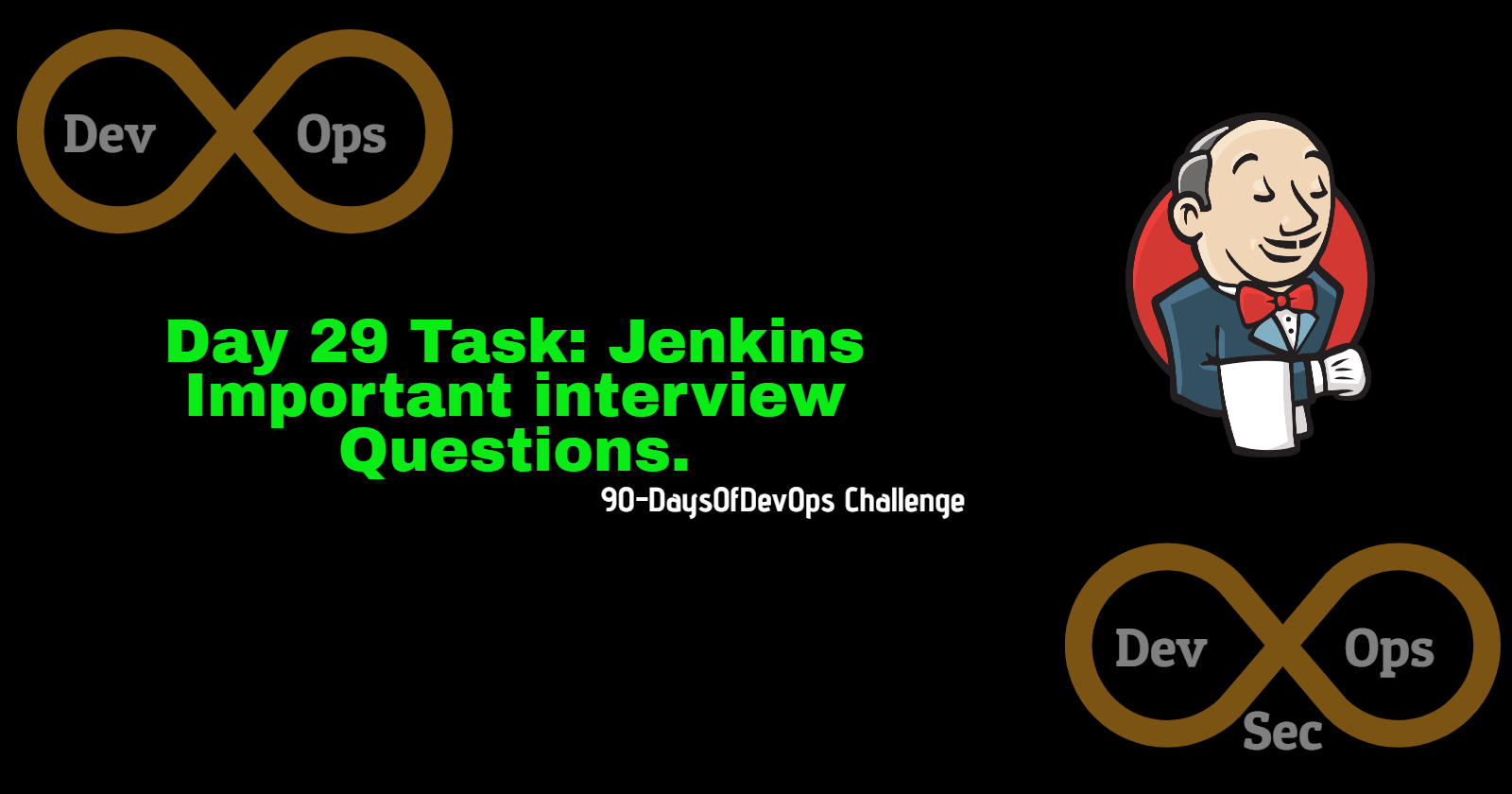Day 29 Task: Jenkins Important interview Questions.
 sri parthu
sri parthuTable of contents
- Difference between continuous integration, continuous delivery, and continuous deployment?
- Benefits of CI/CD?
- What is meant by CI-CD?
- What is Jenkins Pipeline?
- How do you configure the job in Jenkins?
- Where do you find errors in Jenkins?
- In Jenkins, how can you find log files?
- Jenkins workflow and write a script for this workflow?
- How to create continuous deployment in Jenkins?
- How to build a job in Jenkins?
- Why do we use a pipeline in Jenkins?
- Is Only Jenkins enough for automation?
- How will you handle secrets?
- Explain different stages in CI-CD setup?
- Name some of the plugins in Jenkins?

Here are the responses to the Jenkins interview questions:
Difference between continuous integration, continuous delivery, and continuous deployment?
Continuous Integration (CI) is the practice of regularly integrating code changes into a shared repository, where automated builds and tests are triggered upon each integration to detect errors early.
Continuous Delivery (CD) extends CI by automating the deployment process to staging environments, enabling frequent and reliable releases. However, the final deployment to production is still a manual decision.
Continuous Deployment is the further extension of CD, where every validated change to the main branch is automatically deployed to production without human intervention.
Benefits of CI/CD?
Faster time to market.
Reduced risk of defects.
Increased collaboration and visibility.
Consistent and reliable releases.
Improved feedback loops.
What is meant by CI-CD?
- CI/CD is a software development practice that combines Continuous Integration (CI) and Continuous Delivery (CD) to automate the software release process, from code changes to production deployment.
What is Jenkins Pipeline?
- Jenkins Pipeline is a suite of plugins that supports the creation, execution, and visualization of continuous delivery pipelines, which are defined using a domain-specific language (DSL) based on Groovy syntax.
How do you configure the job in Jenkins?
- Jobs in Jenkins are configured through the Jenkins web interface by specifying parameters such as source code repository, build triggers, build steps, post-build actions, and notifications.
Where do you find errors in Jenkins?
- Errors in Jenkins are typically found in the build logs of failed jobs. These logs can be accessed from the Jenkins web interface by navigating to the specific build job and viewing the console output.
In Jenkins, how can you find log files?
- Log files in Jenkins are accessible from the Jenkins workspace directory on the server where Jenkins is installed. Additionally, the console output of Jenkins jobs contains the build log, which can be viewed in the Jenkins web interface.
Jenkins workflow and write a script for this workflow?
- Jenkins Workflow is a feature that allows the definition of complex build pipelines using a Groovy-based DSL. An example script for a basic workflow might involve checking out source code from a repository, building the project, running tests, and deploying artifacts.
How to create continuous deployment in Jenkins?
- Continuous deployment in Jenkins can be achieved by configuring a Jenkins pipeline that automates the deployment process, including staging and production environments, with appropriate approvals and safeguards.
How to build a job in Jenkins?
- To build a job in Jenkins, you need to create a new Jenkins job, configure it with build triggers, source code repository details, build steps (such as compiling code, running tests), and post-build actions (such as archiving artifacts or triggering downstream jobs).
Why do we use a pipeline in Jenkins?
- Jenkins Pipeline allows the definition of complex, continuous delivery pipelines as code, enabling better version control, reusability, and visibility of the entire deployment process.
Is Only Jenkins enough for automation?
- No, Jenkins alone may not be sufficient for automation in all cases. While Jenkins is a powerful automation server, other tools and technologies may be required for specific automation needs, such as configuration management (e.g., Ansible), container orchestration (e.g., Kubernetes), or infrastructure provisioning (e.g., Terraform).
How will you handle secrets?
- Secrets management in Jenkins can be handled using plugins like Jenkins Credentials Plugin or HashiCorp Vault Plugin. These plugins allow you to securely store and manage sensitive information such as API keys, passwords, and SSH keys.
Explain different stages in CI-CD setup?
Different stages in a CI/CD setup typically include:
Source code management (SCM) stage: Pulling the latest code changes from the repository.
Build stage: Compiling code, running tests, and generating artifacts.
Deploy stage: Deploying artifacts to staging or production environments.
Test stage: Executing integration, performance, or user acceptance tests.
Approval stage: Manual approval before promoting changes to production.
Release stage: Final deployment to production.
Name some of the plugins in Jenkins?
Some popular Jenkins plugins include:
Pipeline: Supports defining and executing pipelines as code.
Git: Integrates Jenkins with Git repositories for source code management.
Docker: Provides integration with Docker for building and running containerized applications.
SonarQube: Integrates Jenkins with SonarQube for code quality analysis.
Slack: Enables notifications and messaging via Slack.
AWS Pipeline: Provides integration with AWS services for deploying applications to AWS infrastructure.
These responses should help you prepare for Jenkins-related questions in interviews and provide insights into key concepts and best practices in continuous integration and delivery.Day 29 Task: Jenkins Important interview Questions.
Happy Learning
Thanks For Reading! :)
-SriParthu💝💥
Subscribe to my newsletter
Read articles from sri parthu directly inside your inbox. Subscribe to the newsletter, and don't miss out.
Written by

sri parthu
sri parthu
Hello! I'm Sri Parthu! 🌟 I'm aiming to be a DevOps & Cloud enthusiast 🚀 Currently, I'm studying for a BA at Dr. Ambedkar Open University 📚 I really love changing how IT works to make it better 💡 Let's connect and learn together! 🌈👋